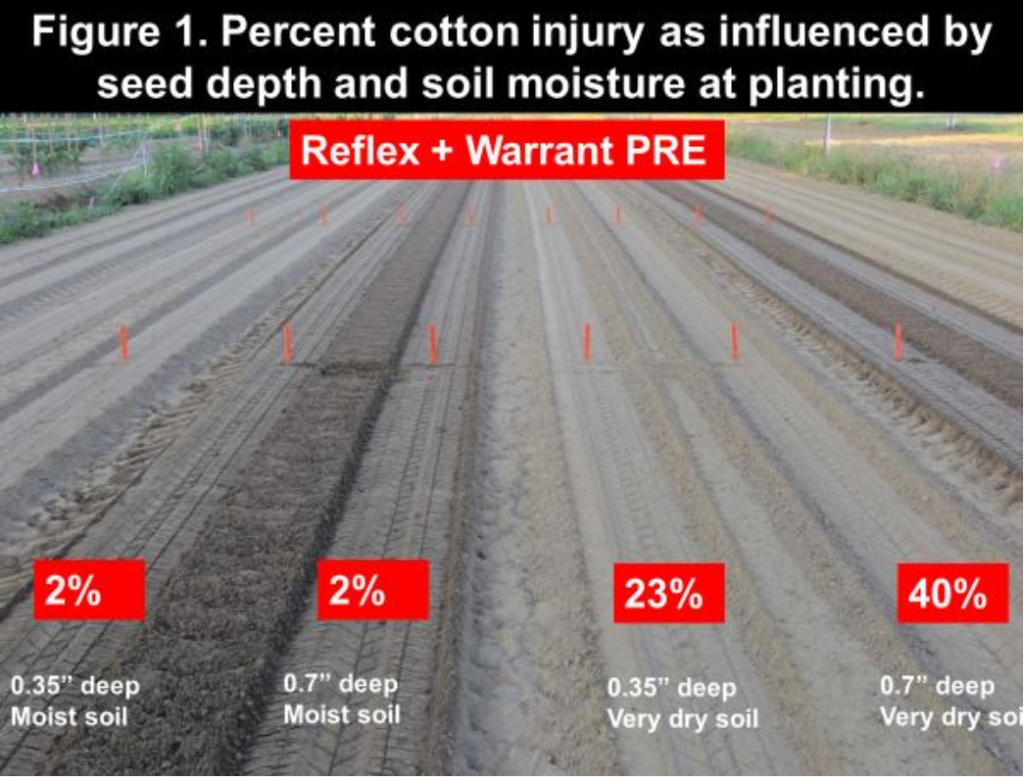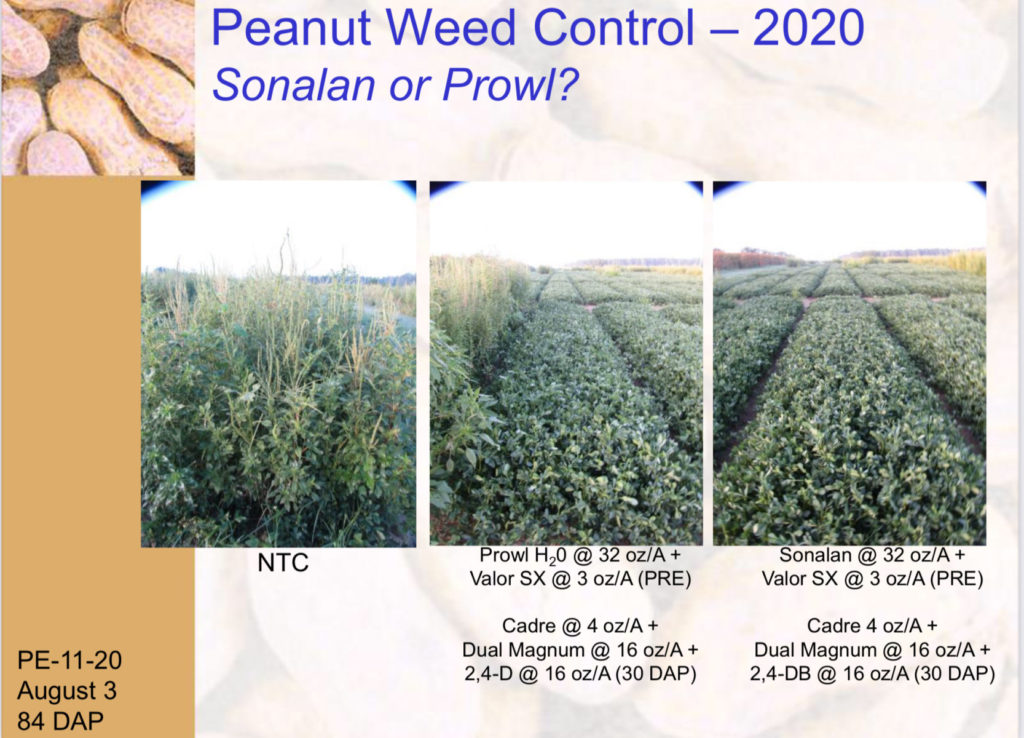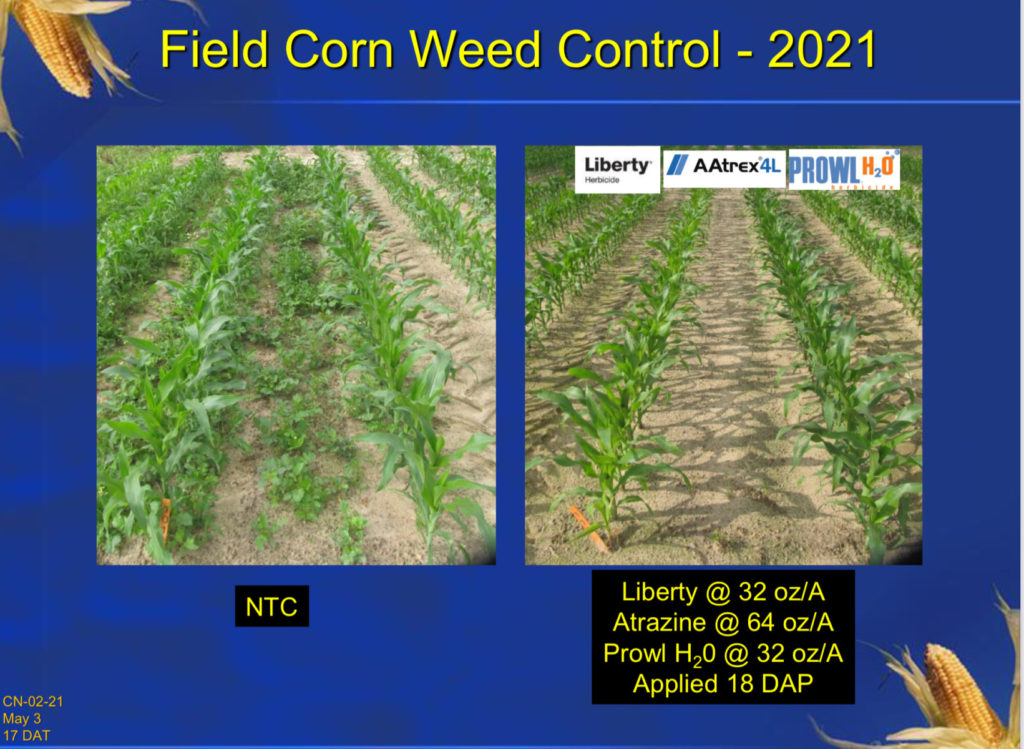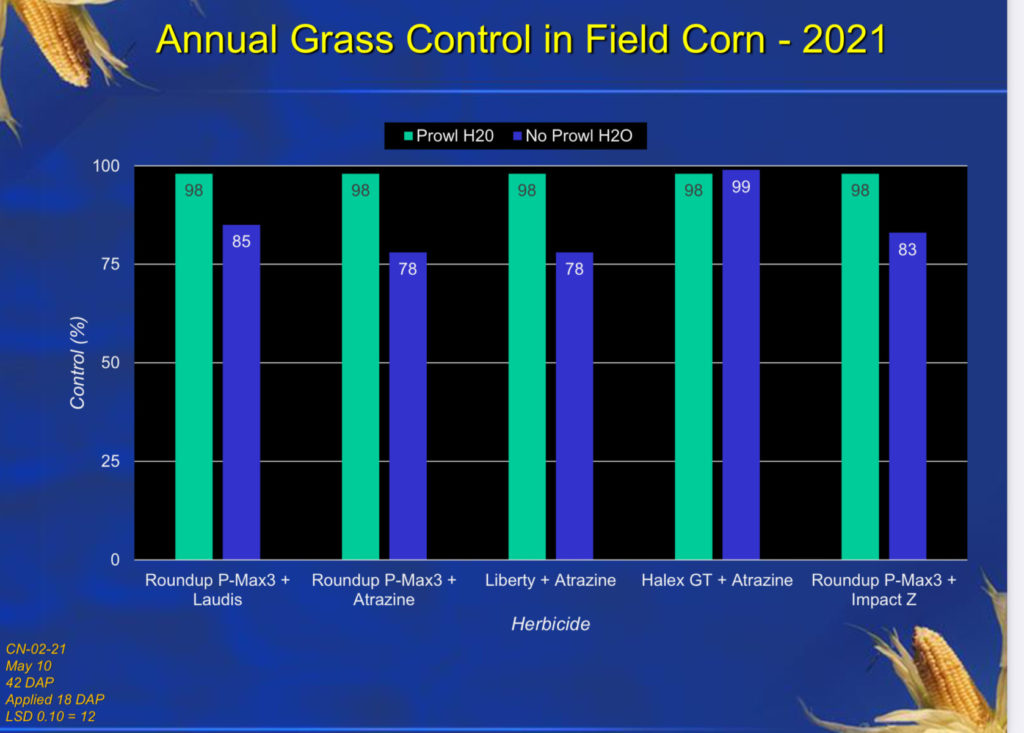Current Situation: This past week growers started planting cotton and peanuts. Presently (May 5, 2022) majority of the area wheat crop is in Feekes 11.1 (milk stage) to Feekes 11.2 (soft dough) stage of development. Corn crop ranges from V2-V7 and growers are side-dressing the corn crop.
Cotton: Herbicides and Dusting in Cotton can be a Mighty Challenge! (Stanley Culpepper): It seems most years, we are extremely dry at some point during planting which challenges our herbicide decisions. Below is an article provided last year that I am resharing without changes as our research continues to support this discussion.
The most effective approach to minimize cotton injury from preemergence (PRE) herbicides is to place the
cotton seed in moist soil where it can imbibe (absorb) clean water free of herbicides (Figure 1). Next, we need our cotton roots to “out run” the herbicide as the herbicide is moving down into the soil with rainfall or irrigation. When placing cotton seed in dry soil and then applying a PRE herbicide, it is likely impossible for water to get to the seed without being contaminated with the herbicide causing a much greater potential for injury.
Thus, dusting cotton in and applying PRE herbicides is far from ideal in regards to avoiding cotton injury.
The next thought from every grower is to hold off on the herbicides until the cotton emerges. This thought is extremely dangerous when considering the monumental challenges our family farms face with herbicide resistance in Palmer amaranth. However, it may be the only option in some environments. If one does follow the path of not using PRE herbicides and planting cotton into dry soils, there are several key points to consider.
First, there needs to be no weeds emerged (especially Palmer) when the cotton seed is placed in dry soil. If there is, get the backhoe out to dig the Palmer up later in the year. In theory, if the field is weed-free when dusting cotton in the soil then no additional weeds should emerge until it rains.
Second, the first postemergence herbicide application should occur as soon as the cotton is fully emerged; the treatment must kill emerged weeds and must include residual herbicides. The level of selection pressure placed on the postemergence herbicide in this situation is very high and not sustainable in time.
Third, a second postemergence herbicide application should be made 12 to 15 days later and again include a residual product, this timing assumes you were timely with the first postemergence application. If you were not timely, the interval needs to be shortened following label recommendations.
And finally, the value of the layby application in fields without a PRE increases astronomically in regards
to herbicide sustainability. Although it is time consuming, it is still better than pulling pigweed!

Question of the week: “Mr. Kichler, our temperatures are going to be in the 90s this week. Do we really need to worry about seedling diseases? More importantly, do our growers need to be worried about adding in-furrow fungicides?”
Answer: Rhizoctonia solani is an important pathogen associated with seedling disease in cotton and peanuts. It is especially severe when soils are cooler and wetter and when seed is planted too deep. It can also be more severe in conservation tillage where soils tend to stay cooler and wetter and organic matter is present. Cooler soils slow germination and growth of seeds and seedlings giving Rhizoctonia a chance to cause significant damage; moisture, especially excess moisture, facilitates fungal growth. When soils are WARM, as they are now, vigorous germination and growth of the seed and seedling greatly reduces risk to damage from Rhizoc. Rhizoc is STILL active and fungicide seed treatments are still absolutely essential, but extra in-furrow treatments for management of Rhizoctonia (and Pythium) are less important than in cold soils.
BUT…….. Rhizoctonia is not the ONLY “bad guy” attacking peanut seedlings, especially in HOT and DRY soils…. Aspergillus niger Is the cause of Aspergillus crown rot, perhaps our most important seedling disease of peanut. Aspergillus crown rot is MOST severe in hot and dry weather when the tender tissue of the young hypocotyl and shoot of the peanut seedling is damaged and cracked by the scorching from the soil. This allows the A niger, which loves heat to infect. Rancona and Trebuset seed treatments go a long way to fighting Aspergillus crown rot as does Velum in-furrow of a grower is already using it for nematode control. Velum (fluopyram) is very good against Aspergillus niger, but is likely too expensive to use ONLY for seedling disease., if soils are hot and dry and cannot be cooked with irrigation or rain, growers may consider using Abound in-furrow, even though it’s efficacy against A. Niger is compromised
Wheat Grain Fill Stages: Wheat irrigation has been a topic among producers. Growers can terminate irrigation when wheat reaches the hard dough stage and moisture is present in the soil profile. When does wheat reach the hard dough stage? Presently (May 1, 2022) majority of the area wheat crop is in Feekes 11.1 (milk stage) to Feekes 11.2 (soft dough) stage of development. Below is a great illustration of wheat stages of development from the Kansas State Extension publication Wheat Growth and Development.
Peanuts: Dr. Mark Abney, UGA Peanut Entomologist, recently posted on his blog Thrips & TSWV Management: This is Your One Chance, Don’t Mess Up.
- UGA research shows that for every 1% Tomato spotted wilt Virus (TSWV) incidence in GA-06G at the end of the season, peanuts lose 20 pounds of yield per acre.
- Most thrips management options and all TSWV management options end when the seed furrow closes.
- Early planted peanuts (prior to 10 May) are at increased risk to thrips injury and TSWV.
- Phorate (Thimet) is the only insecticide that reduces the risk of TSWV in peanut. It doesn’t matter how much we wish there was something else, there is not.
- Everything costs more in 2022, and most people are looking for ways to save money. Consider this: every peanut field in Georgia in 2022 will be infested with thrips, and some of those thrips will be infected with TSWV…100% chance. Thrips and TSWV management may not be the place to cut costs.
- Using Peanut Rx will help growers assess TSWV risk and identify practices that can reduce risk.
- We can do everything right and still have TSWV, but if we plant in high risk situations, there should be no surprise when virus symptoms start to show up in June and July.
- Our one chance to get thrips and TSWV management right, is now. Let’s not mess it up.
Below are a few words from Dr. Bob Kemerait, UGA Plant Pathologist about the current disease situation in cotton and peanuts.
Management of tomato spotted wilt (www.peanutrx.org) requires the right variety + the right planting date + the right choice of insecticide + the right plant population (combination of seeding rate and seed quality and protection of seedlings from diseases and insects). Management of nematodes requires good decisions at planting. The best decisions for managing nematodes require what? The BEST decisions as far as nematodes go require that a grower has some prior understanding of what the risk to nematode is in a specific field before they plant. Field history, history of crop rotation (or lack of rotation) and soil samples collected late last year for nematode analysis all help to make BEST decisions.
Considerations for now:
In Georgia, at least south of the “Gnat Line”, we had a fairly mild 2021-2022 winter. Regrowth cotton and volunteer peanuts and corn survived longer than was helpful and fed the nematodes that didn’t want to go to bed for the winter because soils were warm enough to keep them active. Nematodes in warmer winter soils with a food source just want to stay up late and that leads to more nematodes.
Cotton growers should consider the following in their nematode management plans.
a) Are nematodes are threat to the cotton in their fields? If the answer is “no”, then don’t worry about them this year. If the answer is “yes” or “I don’t know”, then growers should consider ways to protect their cotton crop.
B) A good way to protect the crop is to plant varieties resistant to root-knot or root-knot and reniform nematodes (unless the problem in the field is sting or Columbia lance nematodes).
C) if not planting a resistant variety and the grower has a nematode problem, it will be a tremendous mistake to miss the chance to use a nematicide, or to use a nematicide that won’t get the job done. Fumigation with Telone II (3 gal/A) is our most aggressive and effective solution when a nematicide is used, but it is also most expensive and most complicated. If not fumigation, growers can use AgLogic 15G (a granular product at 5-7 lb/A) or Velum (a liquid product at 6.5-6.8 fl oz/A). Growers can use seed treatment nematicides, but there are most appropriate for lower populations of nematodes. Growers can SUPPLEMENT but NOT REPLACE earlier nematicide applications with Vydate CLV applied at about the 5th true leaf stage.
Peanut growers can follow (should follow) similar advice as above when Peanut Root-Knot nematodes are a threat.
a) Growers can plant Georgia-14N or TifNV-HiOL, both of which have resistance.
b) They can use Telone II (4.5-6 gal/A) of AgLogic 15G (7 lb/A) or Velum (6.8 fl oz/A). Vydate CLV is also labeled and available for use in-furrow for peanuts. We at UGA continue to evaluate Vydate for management of nematodes and thrips. Stay tuned….
Peanuts and in-furrow fungicides.
Most peanut growers will be using Rancona or Trebuset as seed treatments this year, both of which will be better than Dynasty PD for management of Aspergillus crown rot.
Conditions today for our peanut growers COULD indicate “hotter and drier” at planting. Planting peanut seeds into “hotter and drier” soils increases risk to Aspergillus crown rot, especially (but not always) when farmer-saved seed is planted. Also, a “heads up” to growers- Hotter and Drier at planting increases risk to Aspergillus Crown Rot. HOTTER early in the season increases risk to growers for WHITE MOLD (southern stem rot, Dr. Dufault…) as well. Be prepared.
Growers who have used Velum for nematode control will ALSO get additional benefit for control of Aspergillus crown rot. (NOTE: Because of cost and other options, I would not use Velum if I was not first-and-foremost trying to control nematodes. Additional management of crown rot is simply a “bonus”.)
Azoxystrobin (e.g., Abound) in-furrow adds benefit in fighting Rhizoctonia seedling disease (if such is needed) and offers some, but not much extra benefit for Aspergillus control. Coupled with a seed treatment, azoxystrobin in-furrow may not be great (if won’t be) for control of Aspergillus control, but it may be enough.
Proline in-furrow is MOST appropriate for management of Cylindrocladium black rot (CBR) and, to a lesser extent, for early-season white mold control. A banded, concentrated application of Proline 21-35 days after planting would be a better strategy for early-season white mold control. I wouldn’t use Proline simply for extra Aspergillus control.
Mr. Kichler, do I use Prowl or Sonalan on my peanuts? According to Dr. Eric Prostko, UGA Weed Scientist, with the exception of use in reduced tillage systems (i.e. Prowl is preferred there), there have been no consistent differences in peanut tolerance and weed efficacy between Sonalan and Prowl in peanut. It has always been my position that I have no preference between these two herbicides and that every peanut acre in Georgia should be treated with one of them. If a grower is trying to save a few bucks on input costs, there is no reason not to use a cheaper formulation.
The illustration below shows peanut weed control programs using Prowl or Sonalon from Dr. Prostko’s 2020 research.

Corn: What about nitrogen management on my corn? Apply 25 to 30 percent of the projected nitrogen needs before or at planting. The remaining nitrogen can be applied sidedress and/or injected through the center pivot systems (fertigation). If all the nitrogen is applied with ground equipment, apply 50 to 75 pounds per acre at or before planting under irrigated conditions and 20 to 50 pounds per acre in dryland environments and the rest when the corn is 12 to 16 inches tall. If nitrogen is to be injected through the irrigation system, apply 40 to 60 pounds at or before planting and begin ground or injected applications of 30 to 60 pounds of nitrogen per acre when the corn is 8 to 12 inches tall. Continue on a bi-weekly basis until the total required nitrogen is applied. Three to five applications of nitrogen will be needed during the growing season. Nitrogen rates are based off 1.2 lbs per bushel yield goal.
Prowl Programs in corn? I did receive a question or two this week about Prowl in corn weed management programs. According to Dr. Eric Prostko, UGA Weed Specialist, POST applications of Prowl can cause root injury but this usually only occurs when the corn seed has been planted < 1.5″ deep and seed-furrow closure is not adequate. Dr. Prostko is not overly worried about POST applications of Prowl causing unacceptable field corn injury (assuming correct application rate, timing, seed depth, etc.). Below are examples of weed control programs containing Prowl from Eric’s research in 2021.



What happened this week? It has been a busy week. This week we planted one site of the UGA On Farm Variety Trials at the Expo. This year 13 cotton varieties will be put to the test in various yield environments.

I am still getting questions about stubby root nematodes in corn. Below is a great example of stubby root nematode damage.



If you have any questions please contact your county agent..
